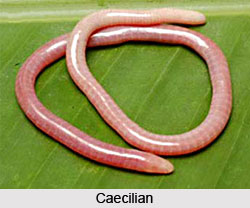 Caecilian is limbless, long-bodied and eel-like amphibian. The eyes are lidless, small and usually indistinct; probably a response to its essentially underground, burrowing habit. A distinctive feature of these animals is the protrudable tentacle on the side of the face located between the eyes and the nostril. The body has a series of transverse grooves within which minute scales may be found. Due to their primitive and unique characters it is presumed that caecilians arose from a different fossil group than did the frogs and salamanders.
Caecilian is limbless, long-bodied and eel-like amphibian. The eyes are lidless, small and usually indistinct; probably a response to its essentially underground, burrowing habit. A distinctive feature of these animals is the protrudable tentacle on the side of the face located between the eyes and the nostril. The body has a series of transverse grooves within which minute scales may be found. Due to their primitive and unique characters it is presumed that caecilians arose from a different fossil group than did the frogs and salamanders.
The most prominent genera in the Indian region are Ichthyophis and Uraeotyphlus. They are distributed throughout the Indian region, being found from the hills of Sri Lanka to the Himalayas. However, they are not met with in the drier parts of their range. The largest concentrations are in the hilly regions or regions of high rainfall. The preferred habitats of these animals are in moist areas near streams and swamps.
The caecilians lay large yolked eggs, but the aquatic larva stage may or may not be present depending on the species. Some species hatch directly into a young adult. Ichthyophis provides a good example of a form with an aquatic larval stage. In Ichthyophis, the female makes a small burrow in the soil by a running stream and lays ten to twenty four eggs in it. The eggs are protected by the female who coils herself around them till they hatch. When the eggs hatch the larvae swim into the stream and from then on fend for themselves. There are no gills in the aquatic larva stage but there is a tail fin that is lost when the adult form is reached.
This article is a stub. You can enrich by adding more information to it. Send your Write Up to content@indianetzone.cominformation to it. Send your write up at content@indianetzone.com



















